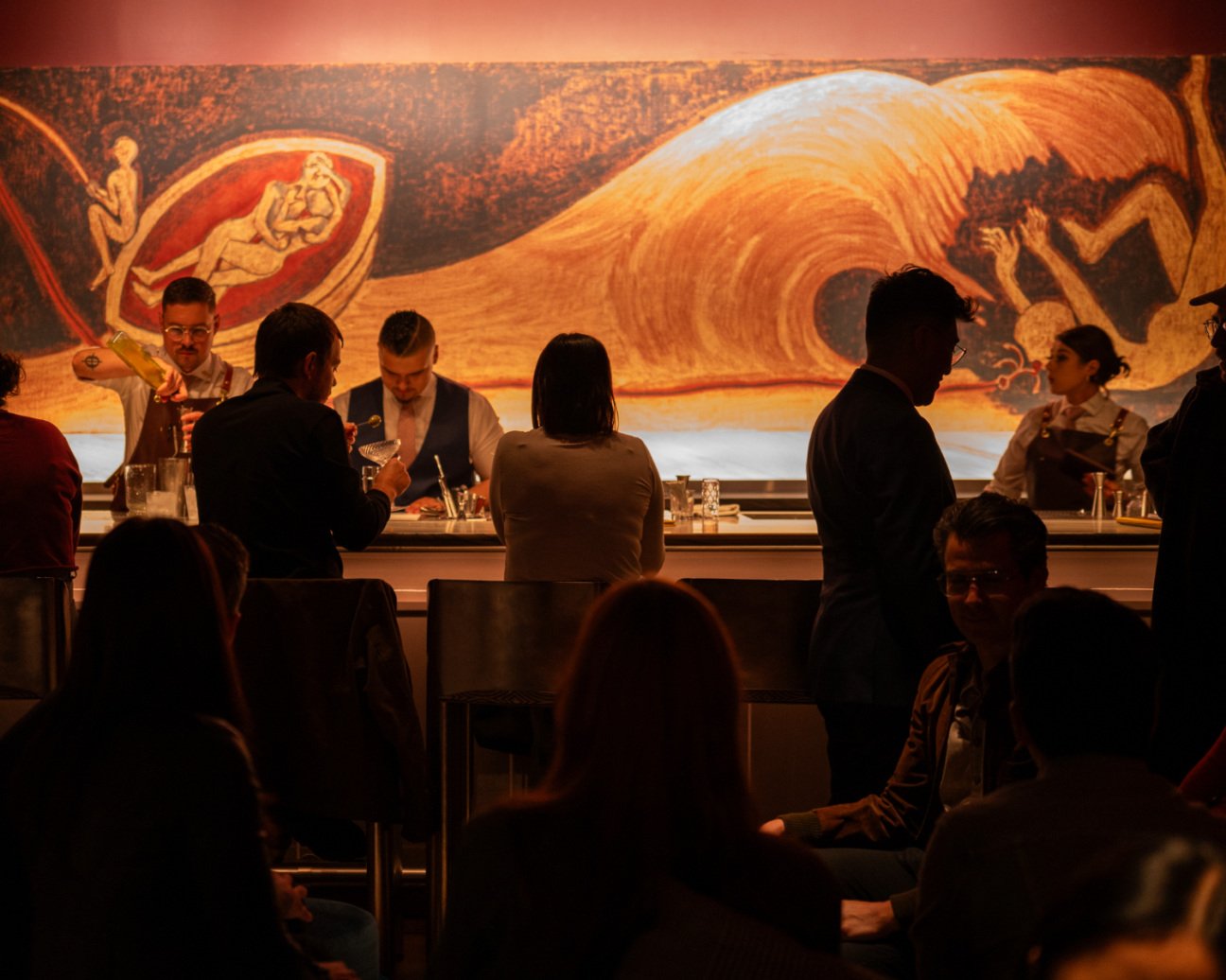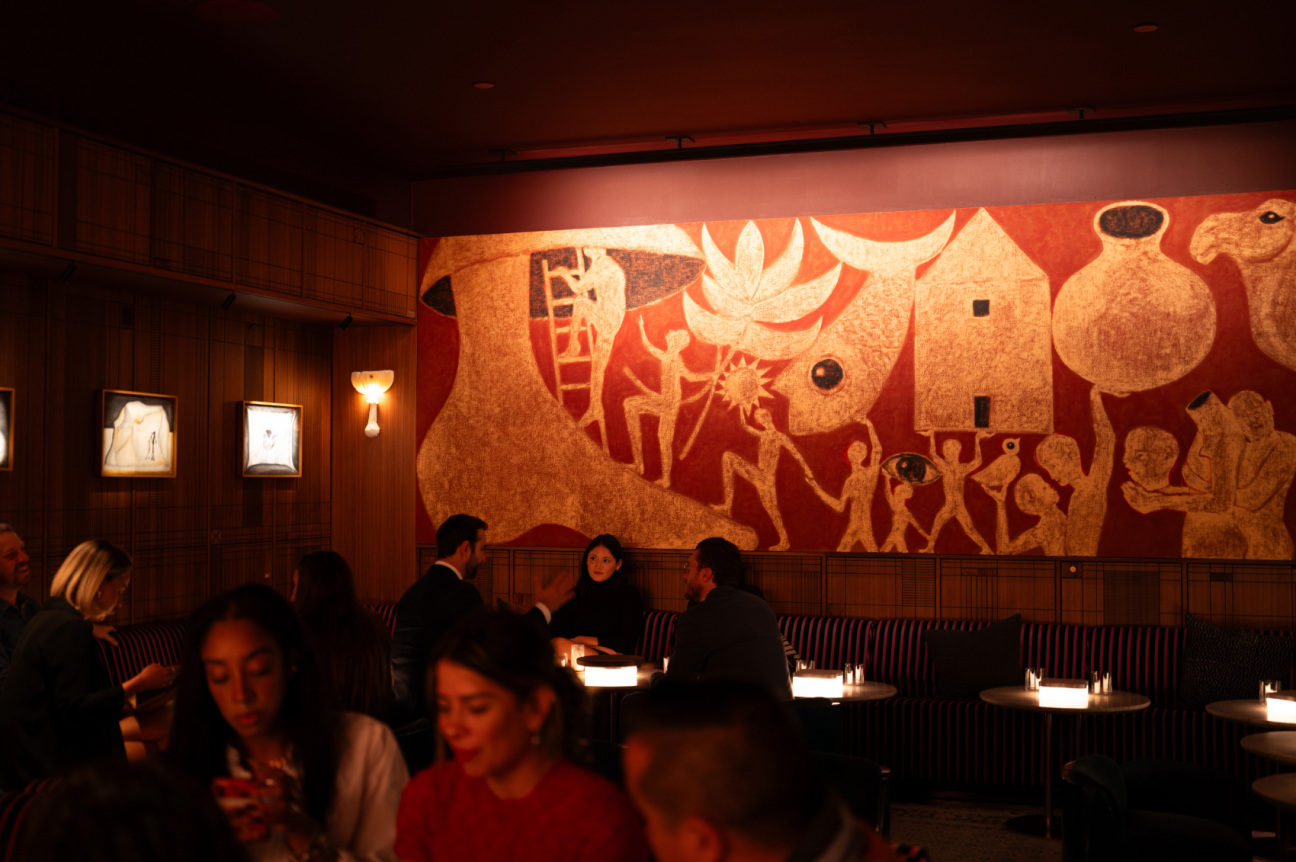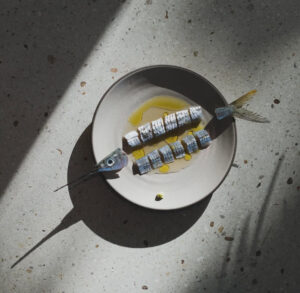
When he was 10, Daniel Humm had a revelation in front of Claude Monet’s “Water Lilies.” There, in the lower level of Paris’s Musée de l’Orangerie, he burst into tears. “I didn’t know why,” Humm recalls. “Was I happy? Was I sad? From that moment on, I knew that I was deeply moved by art.”
Three decades later, Humm joined the ranks of one of Manhattan’s most vaunted eateries. Over his time at the three-Michelin-starred Eleven Madison Park, the chef has transformed the institution into a destination for food—and art. Works by the likes of Olympia Scarry, Rita Ackermann, and Rashid Johnson—also some of Humm’s closest friends—adorn the restaurant’s sleek interior. This fall, the chef escalated this passion, opening Clemente Bar just a few stories below, alongside none other than Francesco Clemente, whose hand-painted frescoes envelop diners in the dreamlike world he’s become known for. Here, the chef reflects on his latest undertaking: a modern monument to the finer senses.

Where are you, and what's in your system?
I'm in New York, in my office, and I've only had coffee so far.
How do you take your coffee?
I just have a cappuccino, and I've had two of them!
How are you feeling a few weeks into the opening of Clemente Bar?
I feel super blessed. This project has been a labor of love, friendship,and trust. Francesco is one of the closest people in my life, and we’ve collaborated with [so many] others, like Brett Robinson, who made the furniture, Carsten Holler, who did the lighting, and Brad Cloepfil, who did the renovation. We also worked with a company called Behind Bars to help design the bar. Everyone has really felt the spirit of this project and elevated each other. This wasn't like a business endeavor—it was a real passion project. Eleven Madison Park has been my whole life for over 20 years. It’s my only restaurant, and for the first time in 27 years, it feels complete.

You’ve said that you've seen Eleven Madison Park's audience evolve a lot over the years. How do you want to engage with a different generation or crowd with Clemente Bar?
It’s really about having a finger on the pulse, and thinking about what was needed now and then. Eleven Madison Park has just been this gift that's kept on giving. But change is in our DNA. To stay the same, we have to change. The goal was to make Eleven Madison Park the best restaurant in the world, and as a chef, I wanted to reach these heights with Michelin stars and accolades and all of that. So you follow a certain rule book, like, What is a restaurant [at that level] supposed to be? When we reached the point of having every award there was to have, it kind of felt empty. By going plant-based, we left that rule book behind.
You're at a stage of your career where you've gotten almost literally every single accolade a restaurant or chef can get, and it's like, “What’s next?” How do you get excited about something new when you've already gotten to the top?
My friends would describe me as endlessly curious. I love collaborating with people I respect. With the Clemente Bar [collaborators], we’re all intense people, and everyone had a very clear idea of what they wanted. Not one of us is easygoing [laughs]. But when it's the right group, it seems easy. A lot of people are labeled as difficult, but then, when the project is right, no one acts difficult… The word that came to mind for me and Francesco was “historic.” These days nothing is permanent, but this is as close as it gets. We were very inspired by this bar called Kronenhalle in Zürich. [Diego] Giacometti made the lighting, and there's Rauschenberg and Picasso paintings. But there are not many places like that—with that kind of permanence.

You’ve already created a monumental restaurant, and now with Clemente Bar, you’re aiming to do it again. How do you balance the gravity of that with a sense of play?
Even with this combination of pedigrees, you’re still worried or nervous. Is it going to work? Will people get what we’re trying to do? Will they make reservations? I didn’t take any of that for granted. Sometimes big names come together, and it doesn’t work. It can almost be dangerous in a way. The fun for us is that Francesco and I are really close. We see each other often, and share at least two meals a week together. So the friendship is the fun part. Now we’re kind of sad that this project is behind us, so we’re like, “What are we going to do next?”
You met Francesco through Vito Schnabel. Do you remember your first impression of him?
Like love at first sight. I always wanted to meet Francesco. I was going to the U.S. Open with Vito, who was at his studio. He was like, “You can come pick me up and say hi.” So we said hi, and we just felt great energy. We saw each other three days later, and it just became a really deep friendship. We share a lot, and he's so wise and knowledgeable and fun and spiritual—all the things that I love about a person.

You’re friends with so many artists—Rashid Johnson, Roni Horn, Olympia Scarry, Rita Ackermann… Why do you think that is? What about them makes it feel like you can connect so deeply?
I have like five people who I’m very close to in my life, and they’re all artists. I feel understood. We put ourselves out there, which is vulnerable, artists know that better than anyone. I’ve always been drawn to creatives. Art and beauty really move me… I've always been interested in moments in art history where artists did something really new, like with the beginning of abstract painting, or Duchamp, or Fontana, who took the canvas and sliced it. Those gestures, which could be so minimal, changed art forever. I always wondered how that could relate to my work. I'm drawn to more elemental dishes, where everything is there for a reason and nothing is extra. During the pandemic, when I realized I could turn the restaurant into a plant-based restaurant, I started to feel like I could step into a space that no one had done before.
What have you seen recently that’s marked you?
The Mark Rothko show at the Fondation Louis Vuitton last year was just beyond. Rothko’s works, especially the black and gray paintings, were so emotional. And more recently, the Thomas Schütte show at MoMA is incredible.
You spoke about these pivotal moments in art either responding to the context of their time or creating an entirely new context. How do you see Francesco’s work at Clemente Bar as part of that lineage?
Franceso asked me if I had any direction around the artwork, and the only thing I said was that I wanted the bar to be joyful. Coming together is so important in these times. It almost feels like a dream when you’re inside the bar. You’re being transported into this other world.

It’s incredible to have art in a space where people can experience it in such an intimate way. As someone who is so deeply steeped in the worlds of food and art, what do you think these worlds can learn from each other?
The beauty of Clemente Bar is that it's not a gallery or a museum, like your head can touch Francesco’s paintings when you lean back. We take the process of the work seriously, but not the rest. That’s a great lesson for restaurants. We should take our work very seriously, but not ourselves: We need to remove a lot of the pretense that comes with the worlds of art and high gastronomy. Food and art are supposed to be enjoyed by everyone, but the worlds that have been created around that for commerce are so filled with ego.
What dish represents where you're at in your life and career right now?
A dish that I always come back to is spaghetti pomodoro. My mom was half Italian and half French, and she made the best spaghetti pomodoro. It's just a reminder that the most simple thing can be elevated, soulful, and transcendent.










 in your life?
in your life?

